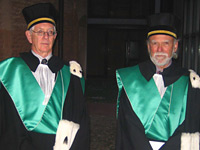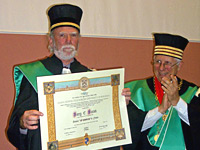Director's Corner
12 October 2006
 Barry Barish |
Pomp and Circumstance
Last week, Sheldon Glashow of Boston University and I made a trip to Italy to receive honorary degrees in physics ("Lauree ad Honorem in Fisica") from the University of Bologna. The ceremony was very impressive, not just for the elegant caps and gowns we wore, but also for the long established traditions that the University carefully followed.
The University of Bologna is the oldest continuously operating university in the world, with a very proud tradition in science. Most appropriately, the subject of my "graduation speech" focused on the International Linear Collider, entitled "The Future of Particle Physics: the Case for Building another Huge Particle Accelerator." Shelly gave his talk on "Simplicity, Symmetry and Small Matrices," a theme that runs through his brilliant career in theoretical physics.
 Sheldon Glashow, Nobel Laureate in Physics, and Barry Barish receiving honorary degrees from the University of Bologna. |
 Me, my doctoral certificate and the Rector of the University. |
Throughout its more than 900 years of history, many famous people studied or taught at the University of Bologna. Two of the most famous persons in the present era are Romano Prodi, the Prime Minister of Italy, and Umberto Eco, Professor of Semiotics and the acclaimed author of many novels, including "The Name of the Rose" and "Foucault's Pendulum." Both Prodi and Eco have served on the faculty.
Two notable physicists associated with the University of Bologna are Luigi Galvani and Guglielmo Marconi. Galvani, an 18th century physicist and physician, conducted experiments on dissected frogs where he discovered that muscle and nerve cells produce electricity. Marconi is best known for his development of the wireless radiotelegraph, for which he shared the 1909 Nobel Prize in Physics with Karl Braun. In his early work at Bologna, Marconi used spark-gap transmitters and coherent-receivers to transmit a signal for the first time over a long distance and even over a hill. Although the physics was not understood at the time, the key to this long transmission was a ground connection to the antenna, making the earth an effective wave guide.
We not only attended the ceremony to be awarded our honorary degrees, but we also had to do some work. There was a special symposium about "Physics Beyond the Standard Model" connected with the award ceremony, and we participated in a public event, coordinated by Paola Catapano from CERN. The public event had a challenging and provocative theme, "From quarks to mobile phones: what's the use of particle physics in daily life?" Alavaro De Rujula (CERN) joined Shelly and me for this event. We each made a short presentation, and I tried to answer the question, "What's the Value of the ILC to Society?" In an open session we responded to some very spirited questions from the public.
I thoroughly enjoyed, but was also humbled by this event. The ceremony, our interaction with the faculty and students and our participation in the public event were important reminders that all of us need to communicate the excitement and importance of our science well beyond our own community.
-- Barry Barish